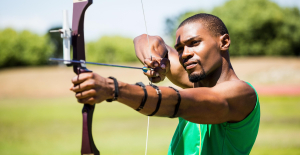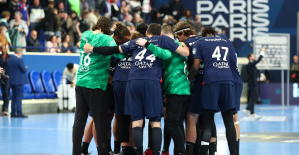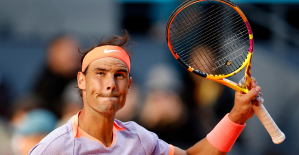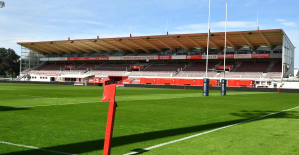The campfire crackles. Sparks rise in the sky. A shooting star passes by. These images are easy to capture with the human eye. But with a camera?
Hand-held shots at night and at dusk tend to be blurred. But if you now attach a flashlight to provide the surroundings with light in the dark and to illuminate the object, you may destroy the entire atmosphere. So what to do to get the perfect low-light photo?
If you own a modern camera, you can lean back: "The sensors of modern cameras are so bright today that photographers hardly need to use flash, especially if fast lenses are used," says Sophia Zimmermann from the specialist magazine "c't Fotografie". A flash would destroy this mood with hard light - the photo looks artificial.
Cameras that are no more than about five years old usually capture dim light, such as in restaurants, churches or a scene around a campfire, in an atmospheric and sharp way all by themselves. This also applies to smartphones.
"In modern smartphones with an integrated night mode, several photos are automatically taken one after the other and the integrated software calculates them into one photo that is relatively well lit," says Zimmermann. Even photos of the night sky can be successful with it. The amount of light to be captured can also be varied manually if necessary by adjusting the exposure time, aperture and ISO sensitivity of the camera. With the highest possible ISO number, the sensor absorbs more light.
But be careful: "Depending on the camera, interference signals can occur, such as background noise, which is why 'pushing' does not suit every motif," explains Zimmermann. Photographers call image noise the disturbances caused by blurry or incorrectly assigned pixels.
Current digital cameras with small sensors still shoot noise-free with ISO 3200, high-quality full-frame cameras with over ISO 6400. "This allows for atmospheric evening scenes, but not necessarily high-resolution portraits," says the expert.
Professional photographer Daniel Wollstein also uses artificial light carefully. “I usually do without a flash unit for events and reports. On the other hand, I consciously use flash for sports photography, portraits and certain still lifes,” says Wollstein. For fast movements such as sports, flash light freezes the movement in low light conditions.
Photography is a game of light and shadow. Without light, no structures can be worked out on the object, details and facial features remain unrecognizable. The distance from the light source is responsible for the intensity, size and harshness of the shadows.
When used consciously, flashing light offers a number of advantages. “A flash controls the direction of the light manually. This allows photographers to determine the direction of the light themselves and use it creatively, which is ideal for portraits,” says Wollstein.
However, the professional photographer avoids mounting a flash unit on his camera. That usually seems “very hard and flat,” he says. "For portraits, I tend to use a head light and a side light to create a mood," explains Wollstein. However, since flash devices generally offer more power than permanent light sources and they can be controlled better, professionals prefer to use flash systems for photo shoots.
Andreas Lindlahr, a professional photographer from Hamburg, advises amateurs to use the flash with caution. This includes, for example, a subtle flash that a viewer of the later photo does not necessarily recognize, or a backlight flash to weaken a harsh light-shadow contrast. However, correct flashing requires a lot of practice and has to be recalibrated for each new photo situation.
Inexpensive clip-on flashes that can be operated manually are available for less than 100 euros, says Zimmermann from "c't photography". However, Andreas Lindlahr advises investing the money in a tripod.
Because: "No photographer works without blurring." Long exposure times can be achieved with a tripod without the photo blurring. Depending on the subject, a flash is thus superfluous.
Even small tripods for smartphones help to take sharp photos with a slow shutter speed of up to three seconds - usually long enough to document the magical evening by the campfire.
However, a tripod only replaces the flash in certain situations, such as a portrait or still life. A long exposure time catches enough light and the object is sharp - but only if it is not moving.
"Everything on shares" is the daily stock exchange shot from the WELT business editorial team. Every morning from 7 a.m. with our financial journalists. For stock market experts and beginners. Subscribe to the podcast on Spotify, Apple Podcast, Amazon Music and Deezer. Or directly via RSS feed.

 United States: divided on the question of presidential immunity, the Supreme Court offers respite to Trump
United States: divided on the question of presidential immunity, the Supreme Court offers respite to Trump Maurizio Molinari: “the Scurati affair, a European injury”
Maurizio Molinari: “the Scurati affair, a European injury” Hamas-Israel war: US begins construction of pier in Gaza
Hamas-Israel war: US begins construction of pier in Gaza Israel prepares to attack Rafah
Israel prepares to attack Rafah Spain is the country in the European Union with the most overqualified workers for their jobs
Spain is the country in the European Union with the most overqualified workers for their jobs Parvovirus alert, the “fifth disease” of children which has already caused the death of five babies in 2024
Parvovirus alert, the “fifth disease” of children which has already caused the death of five babies in 2024 Colorectal cancer: what to watch out for in those under 50
Colorectal cancer: what to watch out for in those under 50 H5N1 virus: traces detected in pasteurized milk in the United States
H5N1 virus: traces detected in pasteurized milk in the United States Private clinics announce a strike with “total suspension” of their activities, including emergencies, from June 3 to 5
Private clinics announce a strike with “total suspension” of their activities, including emergencies, from June 3 to 5 The Lagardère group wants to accentuate “synergies” with Vivendi, its new owner
The Lagardère group wants to accentuate “synergies” with Vivendi, its new owner The iconic tennis video game “Top Spin” returns after 13 years of absence
The iconic tennis video game “Top Spin” returns after 13 years of absence Three Stellantis automobile factories shut down due to supplier strike
Three Stellantis automobile factories shut down due to supplier strike A pre-Roman necropolis discovered in Italy during archaeological excavations
A pre-Roman necropolis discovered in Italy during archaeological excavations Searches in Guadeloupe for an investigation into the memorial dedicated to the history of slavery
Searches in Guadeloupe for an investigation into the memorial dedicated to the history of slavery Aya Nakamura in Olympic form a few hours before the Flames ceremony
Aya Nakamura in Olympic form a few hours before the Flames ceremony Psychiatrist Raphaël Gaillard elected to the French Academy
Psychiatrist Raphaël Gaillard elected to the French Academy Skoda Kodiaq 2024: a 'beast' plug-in hybrid SUV
Skoda Kodiaq 2024: a 'beast' plug-in hybrid SUV Tesla launches a new Model Y with 600 km of autonomy at a "more accessible price"
Tesla launches a new Model Y with 600 km of autonomy at a "more accessible price" The 10 best-selling cars in March 2024 in Spain: sales fall due to Easter
The 10 best-selling cars in March 2024 in Spain: sales fall due to Easter A private jet company buys more than 100 flying cars
A private jet company buys more than 100 flying cars This is how housing prices have changed in Spain in the last decade
This is how housing prices have changed in Spain in the last decade The home mortgage firm drops 10% in January and interest soars to 3.46%
The home mortgage firm drops 10% in January and interest soars to 3.46% The jewel of the Rocío de Nagüeles urbanization: a dream villa in Marbella
The jewel of the Rocío de Nagüeles urbanization: a dream villa in Marbella Rental prices grow by 7.3% in February: where does it go up and where does it go down?
Rental prices grow by 7.3% in February: where does it go up and where does it go down? Even on a mission for NATO, the Charles-de-Gaulle remains under French control, Lecornu responds to Mélenchon
Even on a mission for NATO, the Charles-de-Gaulle remains under French control, Lecornu responds to Mélenchon “Deadly Europe”, “economic decline”, immigration… What to remember from Emmanuel Macron’s speech at the Sorbonne
“Deadly Europe”, “economic decline”, immigration… What to remember from Emmanuel Macron’s speech at the Sorbonne Sale of Biogaran: The Republicans write to Emmanuel Macron
Sale of Biogaran: The Republicans write to Emmanuel Macron Europeans: “All those who claim that we don’t need Europe are liars”, criticizes Bayrou
Europeans: “All those who claim that we don’t need Europe are liars”, criticizes Bayrou These French cities that will boycott the World Cup in Qatar
These French cities that will boycott the World Cup in Qatar Archery: everything you need to know about the sport
Archery: everything you need to know about the sport Handball: “We collapsed”, regrets Nikola Karabatic after PSG-Barcelona
Handball: “We collapsed”, regrets Nikola Karabatic after PSG-Barcelona Tennis: smash, drop shot, slide... Nadal's best points for his return to Madrid (video)
Tennis: smash, drop shot, slide... Nadal's best points for his return to Madrid (video) Pro D2: Biarritz wins a significant success in Agen and takes another step towards maintaining
Pro D2: Biarritz wins a significant success in Agen and takes another step towards maintaining


















